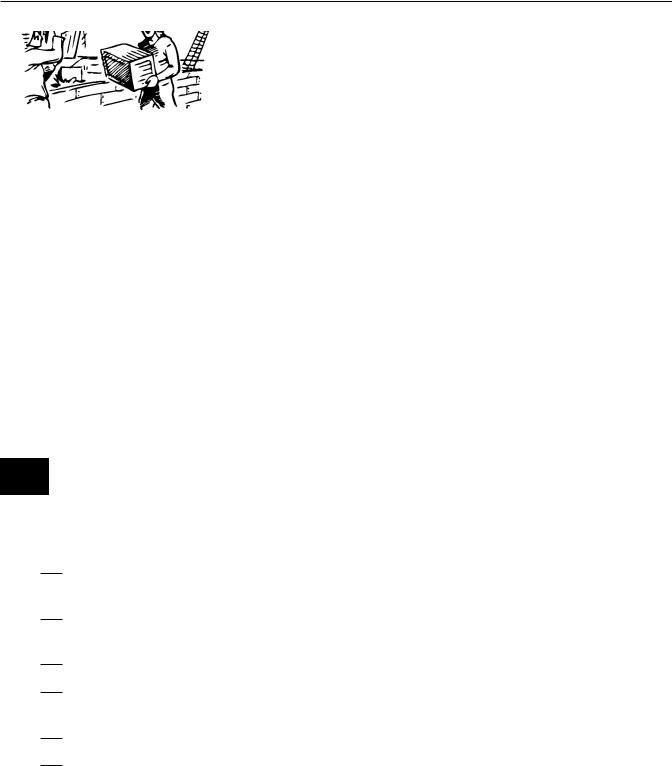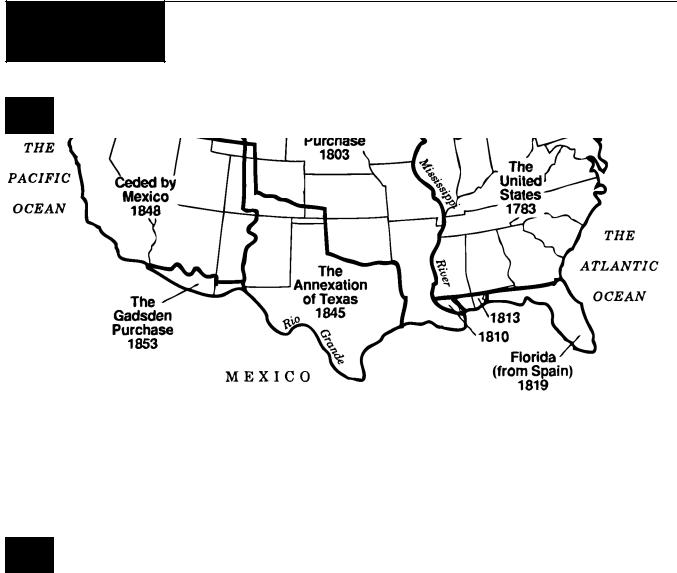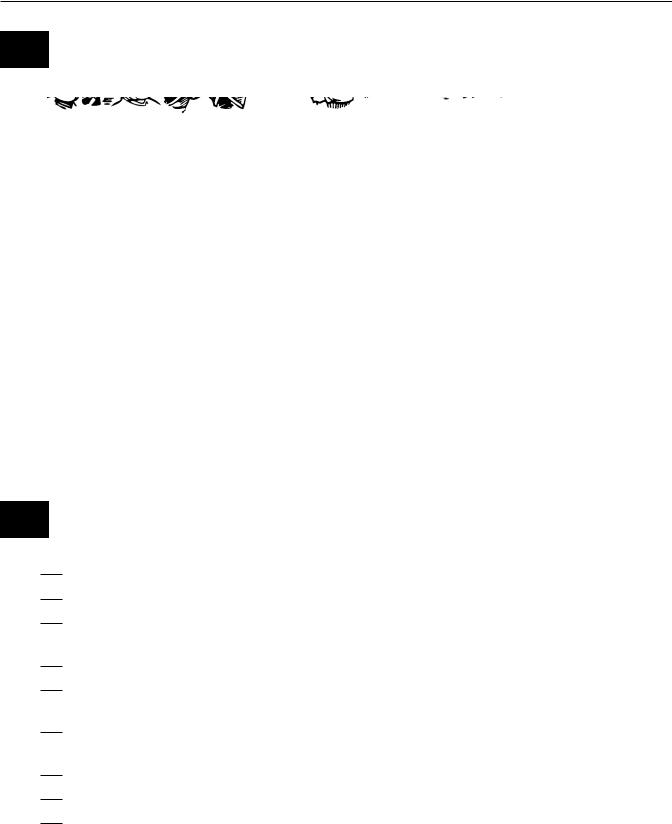
about_the_usa
.pdf
52 Module 4C / Revolution
Module 4C: Revolution
A The Causes of the American Revolution
1. |
The King of England allowed the thirteen American colonies a |
|
large amount of self-government. One of the reasons for this |
freedom was that between 1689 and 1763 England was busy with wars against France. The colonists helped the Mother Country (England) against the French in the French and Indian War.
2. |
In 1763 the war ended, and England won control over most of |
|
the colonies of North America. But by this time the colonists |
|
felt they were “Americans.” They often traded with other |
|
countries. They felt strong, and they did not need the Mother |
|
Country for protection in wars anymore. They were used to |
|
freedom and self-government. |
3.
But the English needed the colonies for economic reasons. They were buying goods from the colonies at low prices and selling back manufactured products at high prices. They were also charging high taxes on American trade with other coun tries. Then England put new taxes on the colonists, such as the Stamp Act (taxes on printed materials).
4. |
Other strict laws made life difficult for the colonists. For |
|
|
|
example, they could send their products only on British ships, |
|
and they had to sell some goods only to England at very low |
|
prices. British officials could enter homes to search for illegal |
|
goods. The colonists were not free to settle west of the Appala |
|
chian Mountains, and they had to allow British soldiers to live |
|
in their homes. |

UNIT 4 / The History of the United States 53
The colonists were especially angry about the “taxation with out representation.” They had to pay high taxes but could not send delegates to England to vote on them. In 1773 England passed the Tea Act (taxes on imported tea), so some colonists dressed up like Indians and dumped all the tea from a British ship into Boston harbor. This act was called the Boston Tea Party.
6. |
To punish the colonies and control them more closely, England |
|
|
|
passed even stricter laws. To show their unity against Eng |
|
land, the colonies sent representatives to the First Continental |
|
Congress in Philadelphia. The Congress decided to stop buying |
|
British goods and demanded rights for the colonists in a decla |
|
ration. Americans prepared for war. |
B Here are some causes of the American Revolution. Write B on the lines before the sentences about the British. Write C before the sentences about the colonists.
1.They were used to freedom and selfgovernment and didn’t need the Mother Country for protection anymore.
2.They were buying goods at low prices and selling back manufactured products at high prices.
3.Their lives were difficult because of strict laws about trade, settlement, and soldiers.
4.They were angry about “taxation without representation,” so they dumped tea from a ship into Boston harbor.
5.To punish and have more control, they passed even stricter laws.
6.To show unity, they met at the First Continental Congress and demanded their rights.

54 Module 4C / Revolution
C Match the sentence parts. Write the letters on the lines.
1.The American colonies had a large amount of self-government be cause
2.England got control over North America because
a.they couldn’t get rights from the British.
b.they wanted to punish the colonies for the Boston Tea Party.
c.the colonists couldn’t send representatives to England to vote on taxes.
3.The “Boston Tea Party” occurred because
d.the Mother Country was busy with wars at that time.
4.The English passed even stricter laws because
e. the English won the French and Indian War.
5.The colonies stopped buying British goods and prepared for war because
D Events of the Revolutionary War
Date |
Places |
Some Facts |
|
|
|
April 19, 1775 |
Lexington and Concord, |
British soldiers shot at some Minute |
|
Massachusetts |
Men (colonists ready to fight) at Lex- |
|
|
ington. The colonists fired shots at |
|
|
British soldiers at Concord and began |
|
|
the Revolutionary War. |
|
|
|
June 1775 |
Boston, Massachusetts |
General George Washington led the |
|
(Bunker Hill) |
colonists, but the colonial army did not |
|
|
have enough soldiers, training, or sup- |
|
other colonies |
plies. The British won many battles. |
|
|
|
July 4, 1776 |
Philadelphia, Pennsylvania |
Representatives of the Second Conti |
|
|
nental Congress declared the independ |
|
|
ence of the colonies from British rule. |
|
|
The Congress adopted the Declaration |
|
|
of Independence. |
|
|
|
1778, 1779, 1780 |
the middle and southern |
The colonial army could shoot well, and |
|
colonies |
George Washington gave the soldiers |
|
|
courage. France entered the war on the |
|
|
side of the colonists. |
|
|
|
October 19, 1781 |
Yorktown, Virginia |
The colonial army won some important |
|
|
battles and took control. |
|
|
|
1783 |
Paris, France |
The war ended. American delegates |
|
|
signed a peace treaty with England. |
|
|
America won land and independence. |
|
|
|

UNIT 4 / The History of the United States 55
E Make sentences about the information in D. You can use these sentence patterns.
EXAMPLES: 1. The Revolutionary War began because the British refused to give the American colonists their rights.
2.On April 19,1775, the British shot at some Minute Men at Lexington, Massachusetts.
1. |
|
|
|
|
|
|
because |
|
|
|
|
|
|
|
. |
2. |
On |
|
|
|
, |
|
|
|
|
|
on |
|
|
|
. |
|
|
|
|
|
|
|
|
||||||||
|
|
|
|
|
|||||||||||
|
In |
|
|
(date) |
|
|
|
in |
|
|
(place) |
||||
|
|
|
|
|
|||||||||||
F Study the map and write words from it on the lines.
The United States after the Treaty of Paris (1783)
|
After 1783 the eastern border of |
the |
United States |
was |
(1) |
|
|
the Atlantic Ocean |
, and |
|||||||||
the western border was (2) |
|
|
|
|
. |
The |
(3) |
|
|
|
|
|
controlled |
|||||
(4) |
|
|
and the land west |
of |
the Mississippi |
River. The |
(5) |
|
|
controlled |
||||||||
the land north of (6) |
|
|
. |
|
|
|
|
|
|
|
|
|
|
|
||||

56 Module 4D / Growth and Westward Movement
Module 4D: Growth and Westward Movement
A From the Atlantic to the Pacific in Fifty Years
B Finish these sentences with information from the map in A.
|
After the American Revolution in 1783, the territory of the United |
States stretched from |
|||||||||||||||||||
(1) |
the Atlantic Ocean |
|
|
in the East to (2) |
|
|
|
|
|
in the West. In 1803 President |
|||||||||||
Jefferson bought the territory west of the Mississippi River from France in (3) |
|
|
|
. |
|||||||||||||||||
|
|
|
|||||||||||||||||||
In the year (4) |
|
|
the U.S. obtained the land of the state of (5) |
|
|
|
|
from Spain. |
|||||||||||||
|
|
|
|
|
|||||||||||||||||
The U.S. annexed (added) the territory of (6) |
|
|
|
in 1845. President Polk divided the |
|||||||||||||||||
large (7) |
|
|
|
with Great Britain in 1846, and England received the northern half in |
|||||||||||||||||
Canada. After a war in 1848, (8) |
|
|
ceded (had to give up) the territory from the Louisiana |
||||||||||||||||||
Purchase to the Pacific Ocean. The U.S. paid $10 million in the year (9) |
|
|
for some Mexican |
||||||||||||||||||
land in the Southwest, called (10) |
|
|
. |
|
|
|
|
|
|
|
|
||||||||||

UNIT 4 / The History of the United States 57
C
D
Moving West in Wagon Trains
Circle the correct word or words in each choice. The pictures in C suggest the answers.
Thousands of Americans moved to [1. eastern / western ] territories to start new lives. Groups of over sixty people traveled in [2. cars / covered wagons ]. Six [3. horses / oxen ] pulled each wagon across the land and rivers and over hills at about [4. two / sixty ] miles per hour, so a 2000-mile trip from Missouri to California took about five [5. hours / months ]. No wagon traveled [6. alone / with others ]. Wagon trains were important for protection against the [7. British / Indians ].
At night, the wagons formed a [8. circle / long line ], like a wall around a small town. The men protected the train with [9. guns / bombs ]. The travelers had [10. meetings / slaves ] and made rules for themselves. Everyone worked together, especially in times of danger.

58 Module 4D / Growth and Westward Movement
E Difficult Years in Texas
Before 1836 the Texas area belonged to Spain and then to Mexico. Under the leadership of Stephen Austin, American settlers moved to Texas. The Mexican government wanted these set tlers to become Mexican citizens and Roman Catholics and to free their slaves, but the settlers had other ideas. They demanded local self-government and the same rights as Americans in the United States, such as trial by jury.
The settlers declared their independence from Mexico and formed the Republic of Texas. The Mexican army of General Santa Anna defeated the rebels at the Alamo on March 6,1836. But with the spirit of the battle cry “Remember the Alamo,” Sam Houston and the Texans won a battle at San Jacinto on April 21. They signed a peace treaty with Mexican leaders and elected Houston President of the “Lone Star Republic.”
The Republic of Texas did not become part of the United States for nine years because most northerners opposed the annexation of another slave state.
F Write T for true and F for false. Correct the false sentences.
1.Before 1836 the area of Texas belonged to England.
2.Stephen Austin was the leader of the Mexican Roman Catholics.
3.The settlers in Texas believed in slavery, demanded local self-government, and wanted the rights of Americans.
4.They wanted to separate from Mexico and form their own republic.
5.Santa Anna was the American military leader, and Sam Houston was a Mexican general.
6.The Texans had the spirit to defeat the Mexican army because they remembered the battle at the Alamo.
7.The “Lone Star Republic” was the Republic of Texas.
8.Jefferson Davis became the President of Texas.
9.Texas became part of the U.S. right away because it was a free state.

UNIT 4 / The History of the United States 59
G Some Principles of the Times
In 1823 President Monroe warned European nations not to interfere with the politics of the Western Hemisphere (North and South America). The Monroe Doctrine was an example of the principle of nationalism. By the 1840’s most Americans believed that the United States should expand to the Pacific Ocean because it was their “manifest destiny” (fate). The settlers organized some of the land into “territories,” and these later became states. The following states were admit ted officially into the Union before the time of the Civil War.
|
Became a |
Became a |
|
|
Became a |
Became a |
|
Territory |
State |
|
|
Territory |
State |
|
|
|
|
|
|
|
Vermont |
|
1791 |
|
Arkansas |
1819 |
1836 |
Kentucky |
|
1792 |
|
Michigan |
1805 |
1837 |
Tennessee |
|
1796 |
|
Florida |
1822 |
1845 |
Ohio |
|
1803 |
|
Texas |
|
1845 |
Louisiana |
1804 |
1812 |
|
Iowa |
1838 |
1846 |
Indiana |
1800 |
1816 |
|
Wisconsin |
1836 |
1848 |
Mississippi |
1798 |
1817 |
|
California |
|
1850 |
Illinois |
1809 |
1818 |
|
Minnesota |
1849 |
1858 |
Alabama |
1817 |
1819 |
|
Oregon |
1848 |
1859 |
Maine |
|
1820 |
|
Kansas |
1854 |
1861 |
Missouri |
1812 |
1821 |
|
|
|
|
|
|
|
|
|
|
|
H Correct these false sentences.
1. In the Monroe Doctrine, President Madison warned
European
nations not to interfere
with the politics of Europe.
2.The doctrine was an example of the principle of separatism.
3.Because of the principle of “taxation without representation,” many Americans thought that the U.S. should expand to the Mississippi River.
4.Some of the land became “countries,” and these were later admitted into the House of
Representatives as states.
I Make sentences about the information in G. You can use these sentence patterns.
1. |
|
|
|
was organized as a territory |
|
in |
|
|
|
. |
|||||
|
|
|
|||||||||||||
|
(state) |
|
|
was admitted as a state |
|
(year) |
|
|
|
||||||
|
|
|
|
|
|
|
|
|
|
|
|||||
2. |
|
became a |
|
territory |
|
before |
|
|
|
|
|
. |
|||
|
|
|
|
|
|
|
|||||||||
|
(state) |
|
|
|
|
state |
|
in the same year as |
|
(state) |
|||||
|
|
|
|
|
|
|
|
|
|
|
|||||
|
|
|
|
|
|
|
|
|
|
|
|
|
|
|
|

60 Module 4E / The Time of the Civil War
Module 4E: The Time of the Civil War
A The Causes of the Civil War
In the 1800s the northern and the southern states disagreed on basic issues. Their differences led to the Civil War.
The North... |
The South... |
...lived from industry and the manufacture of goods such as clothing and furniture. North ern factories did not use slaves. The abolition ists (opponents of slavery) worked to free the slaves.
...produced expensive products and got the U.S. government to put a protectionist tax on products from other countries.
...was adding free states to the Union and had a larger population than the South. The northern states had more representatives in Congress than the southern ones.
...believed in the unity of the United States and opposed the separation of the southern states from the Union.
...supported the election of Abraham Lin coln as President of the United States.
...depended on agriculture for its economy. The main crop was cotton, and southern plant ers felt they needed slave workers to make money. They opposed the abolition of slavery.
...preferred cheap European goods to the expensive products of northern factories and opposed the protective tax on them.
...was adding slave states to the Union but had a smaller population than the North. The southern states were losing power in the House of Representatives.
...opposed federal laws and seceded (sepa rated) from the Union by creating the Confed erate States of America.
...opposed the election of Lincoln and chose Jefferson Davis President of the Confederacy.
B Make sentences about the information in A. You can use these sentence patterns and the pictures on the next page for ideas.
1. |
|
The northern states |
|
|
|
|
|
, but the southern states |
|
||||
|
|
|
|
|
|
|
. |
|
|
|
|
|
|
2. |
|
Although the North |
|
|
|
|
, the South |
|
|
. |
|||
3. |
|
The states of the North |
|
|
|
|
|
|
. On the other hand, the |
|
|||
|
states of the South |
|
|
. |
|
|
|
|
|
||||

UNIT 4 / The History of the United States 61
1. |
2. |
3. |
4 |
C Finish each sentence about the map on the next page with the names of different states.
EXAMPLE: During the time of the Civil War, the state of Illinois was free, but Tennessee was a slave state.
1. |
During the time of the Civil War, the state of |
|
|
was free, but |
|
was a |
||||
|
|
|||||||||
|
slave state. |
|
|
|
|
|
|
|
|
|
2. |
The state of |
|
|
seceded from the Union to become part of the Confederacy (the |
||||||
|
Confederate States of America). |
|
|
|
||||||
3. |
Although |
|
|
was a slave state, it did not secede. |
|
|
|
|||
